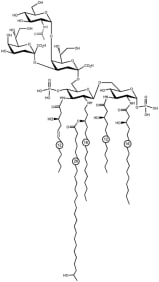Bartonella quintana-derived toll-like receptor 4 antagonist small molecule (tool compound)
Invented by Leo Joosten
Invented at Radboud UMC
- Datasheet
- References (1)
- Inventor Info
Info
| Catalogue Number | 160531 |
| Synonyms | B. quintana LPS, B. quintana LOS. B. quintana Lipooligosaccheride |
| Type | Inhibitor |
| Relevance |
Adapted from Malgorzata-Miller et al Sci. Rep. 6, 34221; doi: 10.1038/srep34221 (2016). Bartonella quintana is a louse-borne Gram-negative pathogen, which colonize the louse alimentary tract enabling a single louse to infect multiple humans. After introduction into the human host, B. quintana can persist in the normally sterile bloodstream for weeks or month. This remarkable, prolonged persistence in the host bloodstream demonstrates the ability of B. quintana to avoid clearance by the host immune defense. Patients with B. quintana bacteremia do not show the classical sepsis syndrome, potentially due to overproduction of the anti-inflammatory cytokine interleukin-10 (IL-10) and an attenuated inflammatory cytokine profile. The inventors of this tool have previously described the anti-inflammatory effect of B. quintana LPS. The molecule blocks TLR4 activation and it has been shown that in several in vitro and in vivo models B. quintana LPS can be used as a potential therapeutic agent for the treatment of rheumatoid arthritis, ventilation-induced lung injury (VILI), atherosclerosis and other autoinflammatory diseases. |
| On Target IC50 |
From Adapted from Malgorzata-Miller et al Sci. Rep. 6, 34221; doi: 10.1038/srep34221 (2016): B. quintana LPS revealed to have an IC50 of 37.04 ng/ml at a dose of 10 ng/ml ultra pure E. coli LPS. Cytokine production in mice challenged with E.coli-derived LPS and B. quintana-derived LPS, measured by ELISA. |
| Selectivity | Toll-like receptor 4 |
| Key Attributes |
- anti-inflammatory - antagonist at Toll-like receptor 4 - able to inhibit E. coli-derived LPS activity at TLR4 which is not reversed by Polymyxin B |
| In vivo applications |
In Malgorzata-Miller et al Sci. Rep. 6, 34221; doi: 10.1038/srep34221 (2016): Wild type mice were injected intraperitoneally (i.p.) with either PBS, or B. quintana LPS 100 μg/mouse. After 30 minutes 10 mice of each group were injected with PBS and 10 mice were injected i.p. E. coli LPS 1 μg per mouse (Escherichia coli LPS 055:B5 Sigma Chemical Co., St Louis, MI, USA) + D-galactosamine 14 mg per mouse. Survival of all 4 groups (PBS + PBS, B. quintana LPS + PBS, PBS + E. coli LPS/D-galactosamine and B. quintana LPS + E. coli LPS/D-galactosamine was assessed for 10 days. |
| Solubility | PBS |
| Research Area | Immunology |
| Storage | -20C |
| Notes |
Adapted from Malgorzata-Miller et al Sci. Rep. 6, 34221; doi: 10.1038/srep34221 (2016). This TLR4 antagonist is actually a lipooligosaccharide (LOS) instead of a LPS, and that it acts very effective, with a high inhibitory activity against triggering by the LPS-TLR4 system in the presence of a potent TLR4 agonist (E. coli LPS). Furthermore, we demonstrate that B. quintana LPS is not inactivated by polymyxin B, a classical cyclic cationic polypeptide antibiotic that bind the lipid A part of LPS, such as E. coli LPS. Using a murine LPS/D-galactosamine endotoxaemia model we showed that treatment with B. quintana LPS could improve the survival rate significantly. Since endogenous TLR4 ligands have been associated with several inflammatory- and immune-diseases, B. quintana LPS might be a novel therapeutic strategy for TLR4-driven pathologies. |









